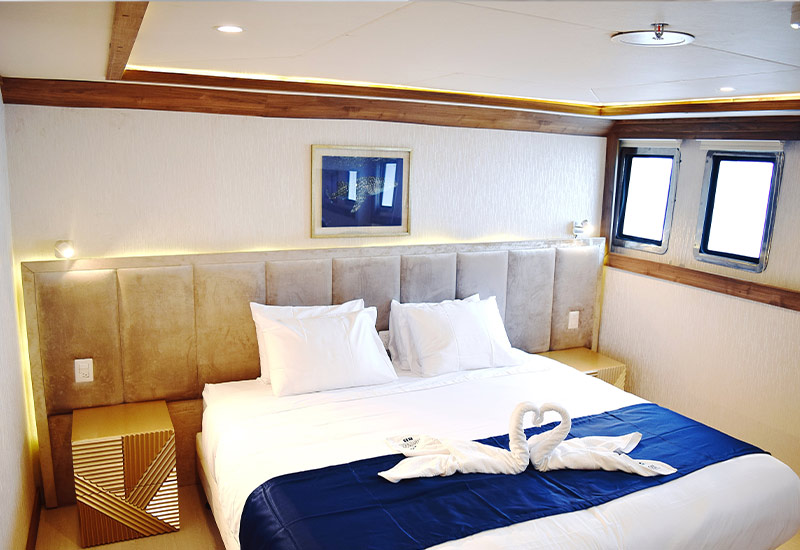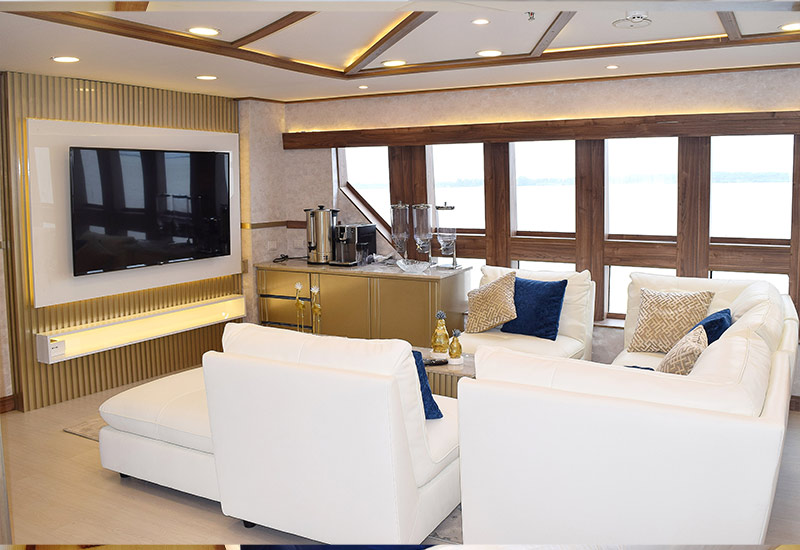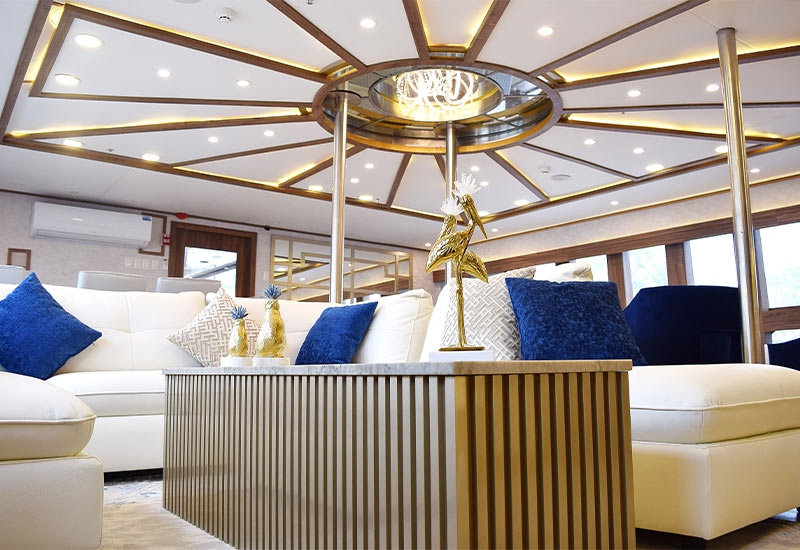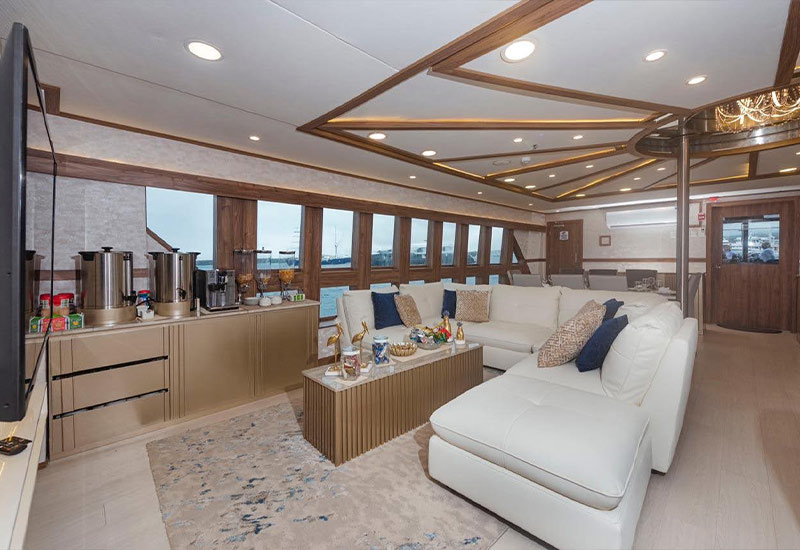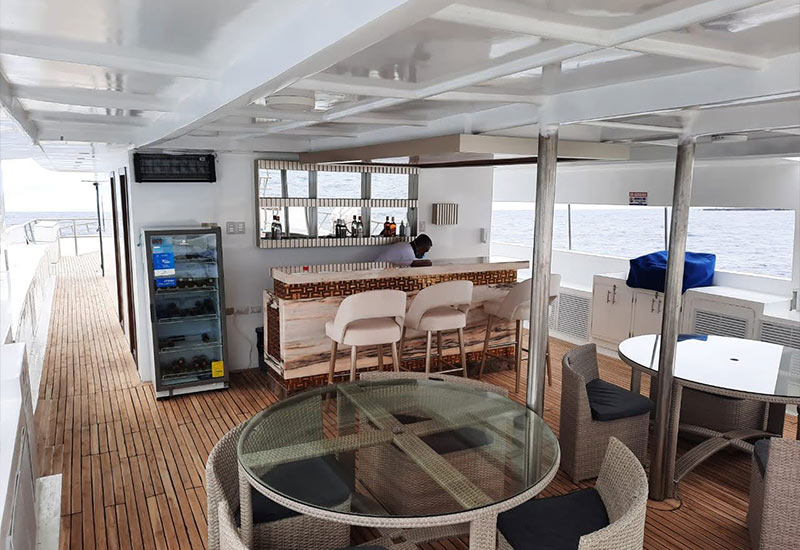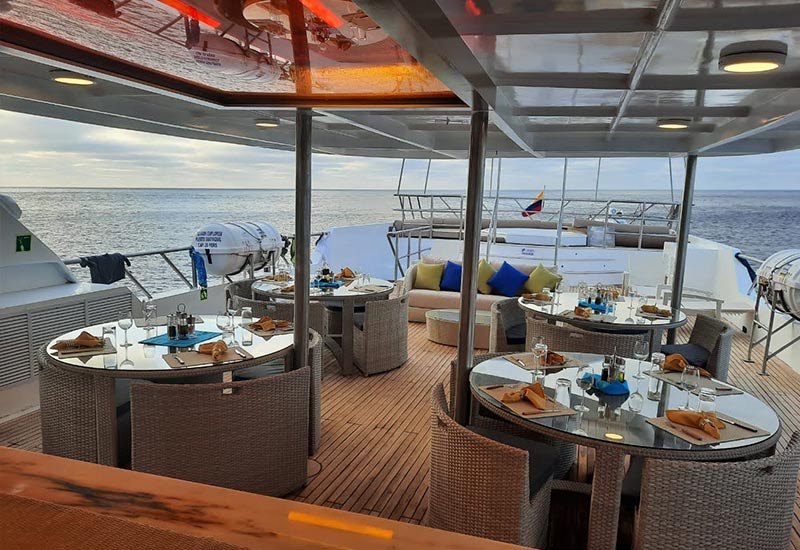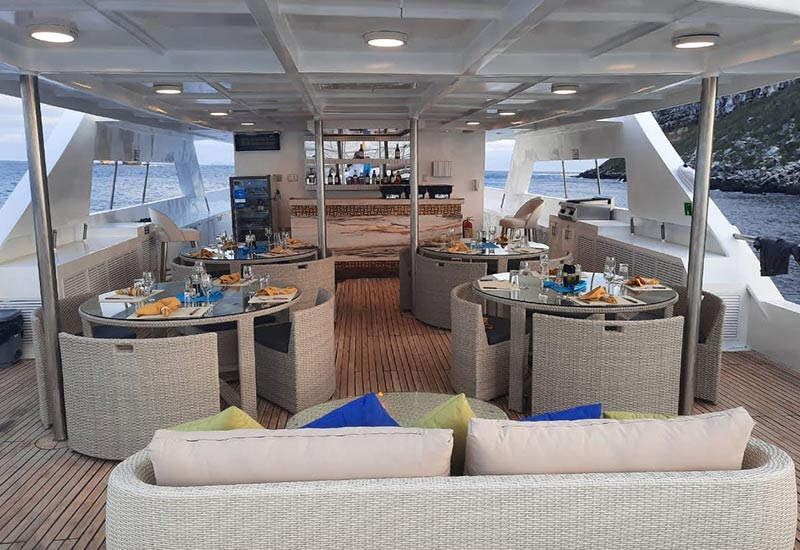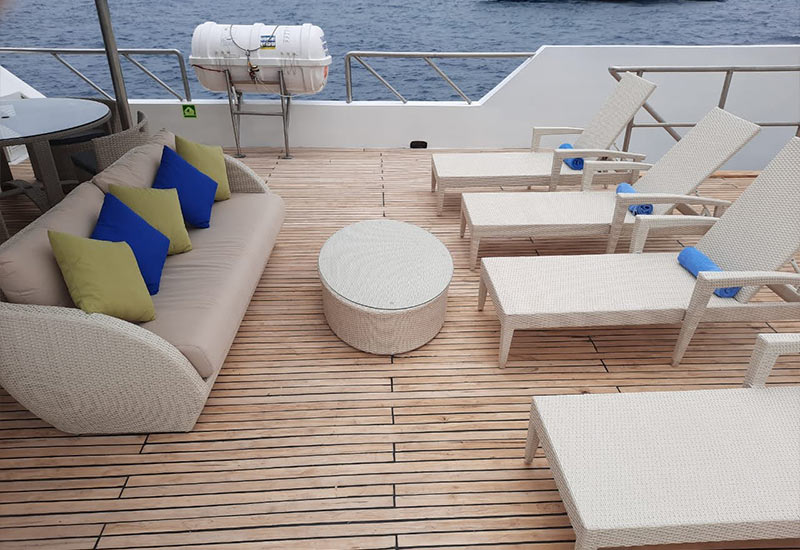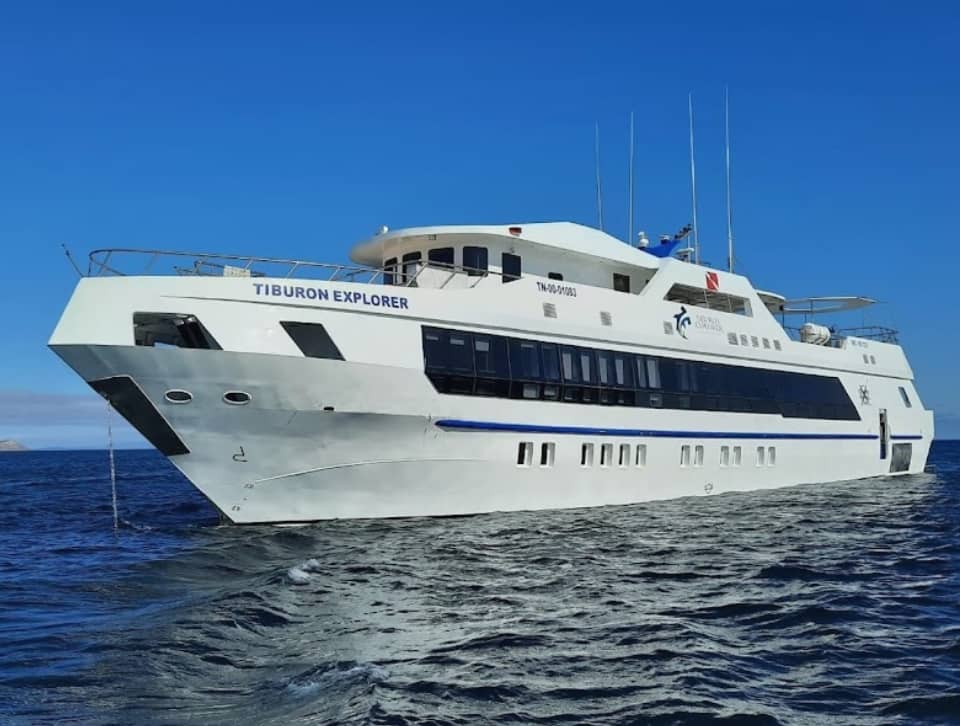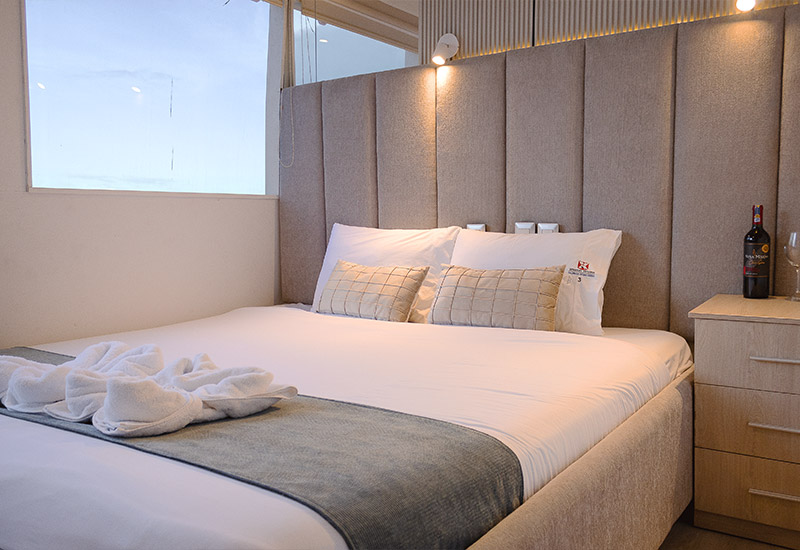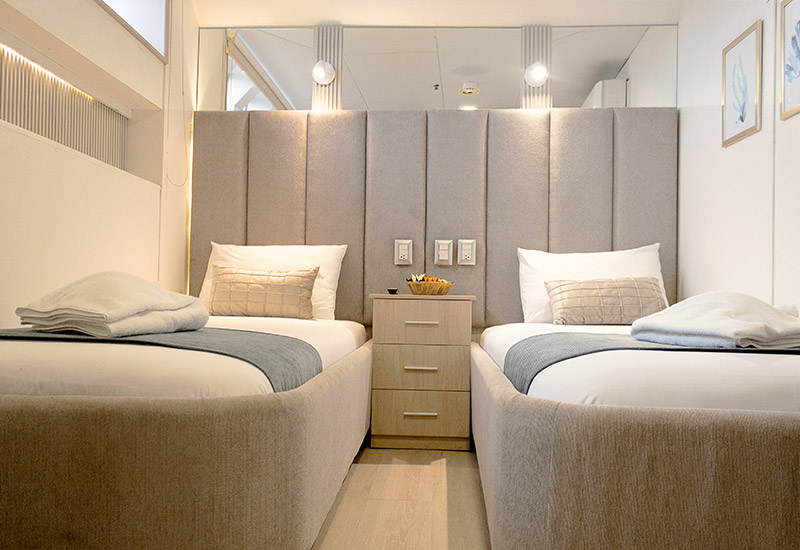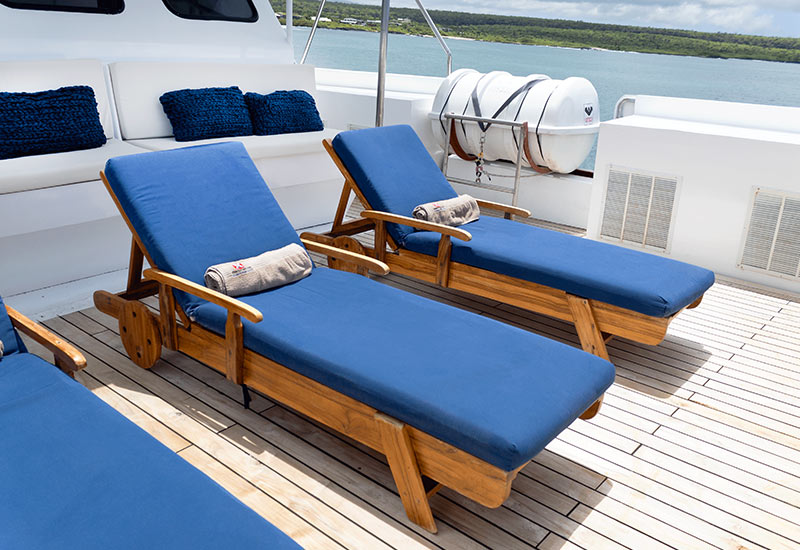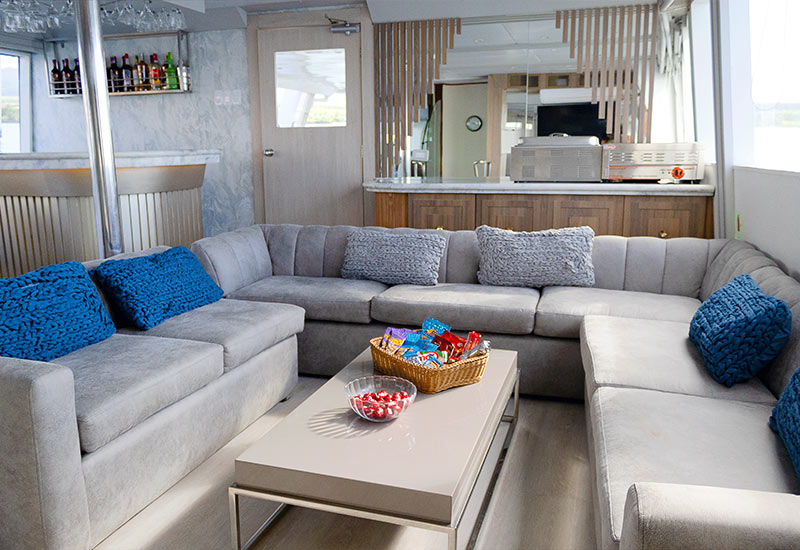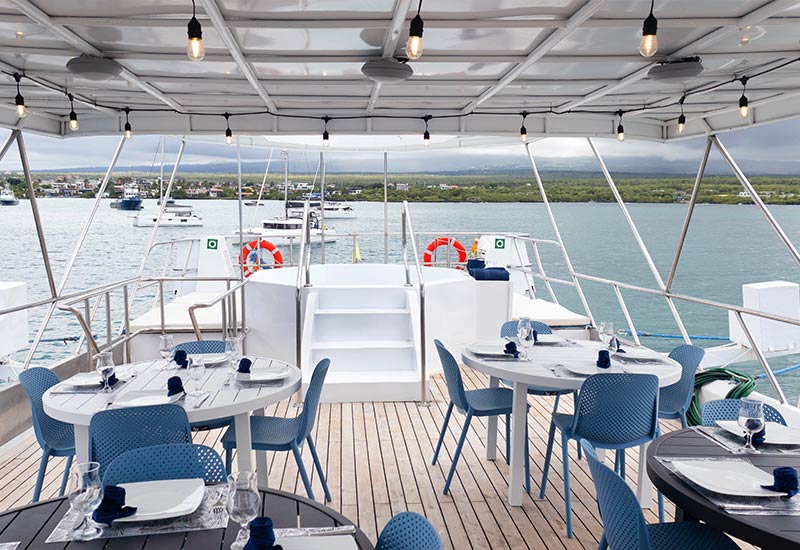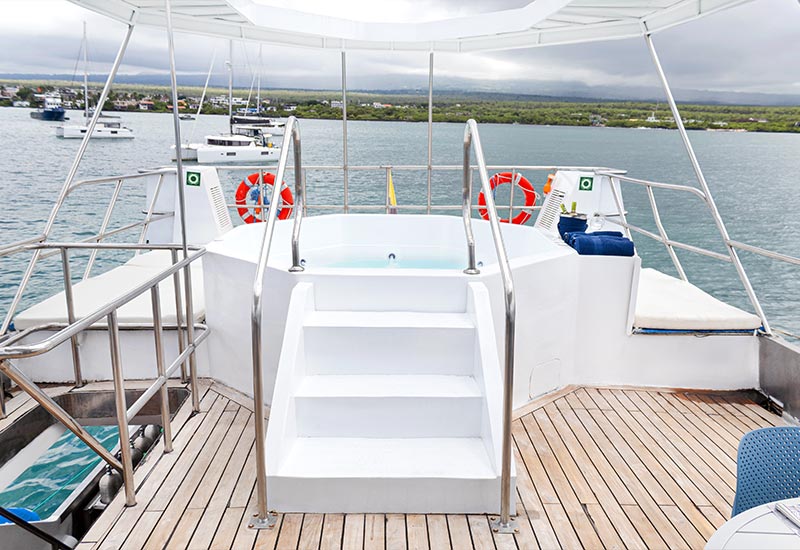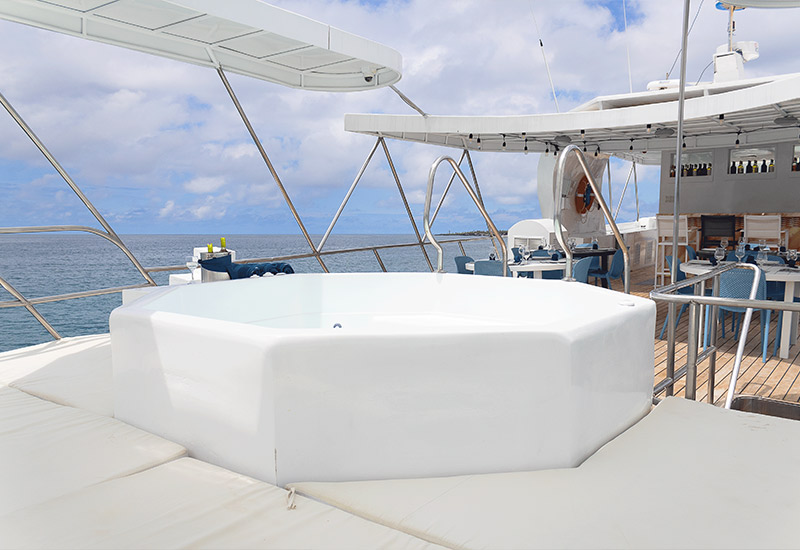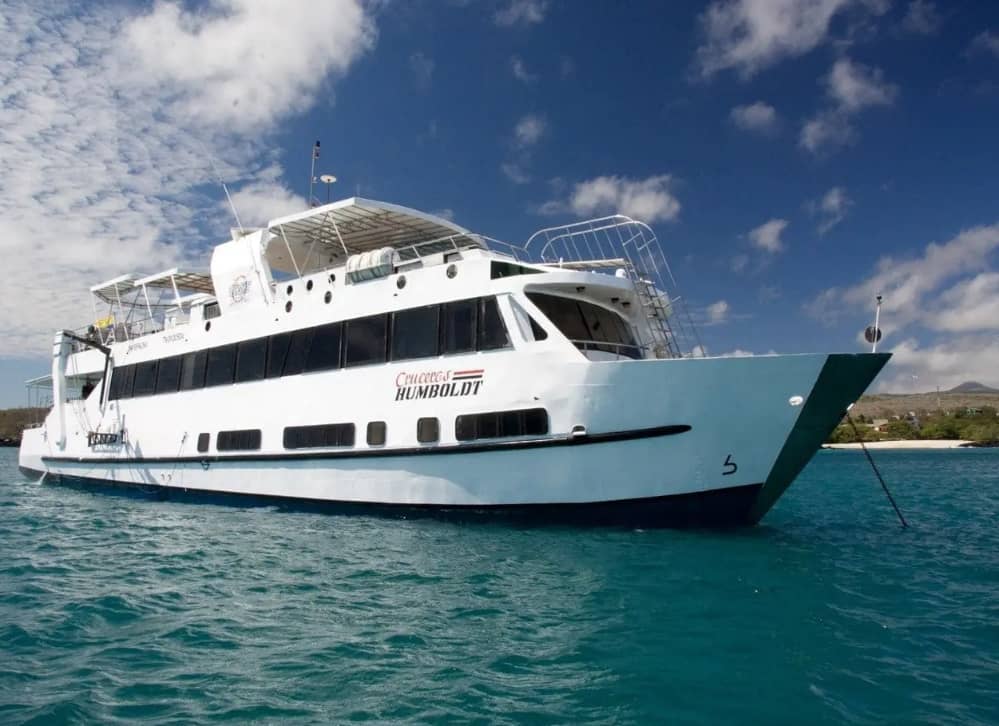Rebreather diving is not permitted onboard. Recreational single tank side mount diving is allowed and divers must bring all necessary riggings, as those are not available for rent. Please contact us for details.
The M/V Tiburon Explorer spaciously accommodates 16 passengers in 9 cabins, all of which have private bathroom facilities and can be configured to accommodate a couple (with a queen bed) or two singles (except cabin 1 & 2, situated on the main deck: queen bed only). Staterooms 1-6 are located on the main deck with staterooms 7-9 located on the lower deck. The top deck is the sun deck, offering both shaded and full-sun areas for relaxation as well as a jacuzzi and the bridge. The large main deck contains the air-conditioned dining and lounge area, multimedia system with TV/DVD/CD, common restroom, and staterooms 1-6. Double doors open to the ample dive platform. The lower deck is accessed via stairs from the salon. The Tiburon Explorer is equipped with a wireless signal that will allow communication via WhatsApp. Cell phone service is available when in proximity to Santa Cruz Island if your phone is so equipped. The vessel’s location does determine the reliability of access to these services. A satellite phone is available for emergency use.
Galapagos is famous for huge schools of hammerheads, but there is more to Galapagos than just its schooling sharks. You will be diving in a protected and healthy marine environment with an abundance of rare species including Galapagos sharks, whale sharks, mantas, mobulas, eagle rays, stingrays, penguins, orcas, dolphins, mola mola, marine iguanas, turtles, sea lions, butterflyfish, tuna, and pufferfish among many others. Galapagos has two seasons. High season is regarded as July to November when the Humboldt current is at is maximum force, bringing upwellings of nutrients from the cold depths. This is your best opportunity to dive with whale sharks in Darwin and Wolf. In these months, the water is cooler, visibility is lower, currents can be stronger and the seas can be rough at times. The air temperature is cooler and evenings can be fresh. The chances of seeing whale sharks are slim during the low season months of December through June. Other popular species, such as the scalloped hammerheads and large schools of fish are present year-round however, making the “low” season desirable if whale sharks are not on your must-see list. Temperatures are warmer and visibility is generally better. Galapagos is a cold-water destination. Regular temperatures in Darwin and Wolf are 21-23°C (70-74°F) but can be warmer in the early months of the year. Thermoclines can dip to 13C (54° F) in the Western Islands of Punta Vincente Roca and Cabo Douglas, which stay cooler year-round.
All dives aboard the Tiburon Explorer are offered at scheduled times, up to 4 times daily (weather & itinerary permitting). Schedules must comply with Galapagos National Park rules, allow for adequate surface intervals and enable the vessel to travel to different locations. Please note that Galapagos regulations limit the maximum depth for all dives to 130 feet (39 meters) with air and 110 feet (33 meters) with Nitrox. We usually do not dive deeper than 100 feet (30 meters). All dives are done from pangas (zodiacs).
The minimum certifiable age for divers is 10 for most SCUBA certification agencies; normally, the agencies restrict 10 and 11-year olds to a maximum depth of 40 feet (12 meters). Children 12-14 years old are restricted to 70 feet (21 meters). Explorer Ventures Fleet therefore allows children as young as 10 years to participate in our trips, with the following restrictions:
To ensure your safety, we require the following of all divers:
The vessel provides tanks, weights, and weight belts for your use. If you prefer to rent the rest of your equipment from us, we have all of the equipment that you will need. Please indicate on your application form what equipment (and size) you will require. Otherwise, the following items are the diver’s responsibility:
* Available for rent on board.
| Diving Equiment Rental Prices Per Person Per Week | |
| Full Scuba Package -BCD, Regulator, Console, wetsuit (does not include computer) | $ 250 |
| Regulator Package with gauges, octopus and inflator | $ 90 |
| Computer | $ 100 |
| BCD | $ 90 |
| Full Body Wetsuit | $ 75 (7mm) |
| Mask & Snorkel | $ 25 |
| Fins/booties | $ 50 |
| DIN/Yoke Adaptor (limited availability) | $ 25 |
| 15 Liters Tank | $ 130 |
| Nitrox fills | $ 150 per week |
Most of our guests bring their own complete set of dive gear. This is the ideal situation; however, due to weight limits or additional travel plans, some of our guests choose to rent gear. We strongly recommend that you bring your own mask, gloves, booties, fins, hood or hooded vest and computer. A personal wetsuit is also a good idea if you have space. Diving in Galapagos can be challenging, and it is important that you are comfortable. Gloves are suggested as the rocks can be sharp and can damage hands
Nitrox is available for an additional charge, as long as the diver is Nitrox Certified.
Nitrox is simply air in which the percentage of oxygen has been increased beyond the 21% normally found in air. Nitrox is created either through the addition of pure oxygen to the mixture, or the subtraction of nitrogen with a membrane system. On our vessels, we use the latter system.
Nitrox diving has many advantages: absorption of less nitrogen into the bloodstream and body tissues, reduced risk of decompression illness for equivalent profiles, and less post-dive fatigue (especially useful on liveaboards!). As with any diving activity, however, diving with nitrox demands careful attention and a special certification.
Enriched air certifications are an excellent chance to improve your skills and knowledge, and takes only about 4 hours of your time, in between dives. No special equipment is required, since we only dive with nitrox mixtures containing less than 40% oxygen. Just ask a dive staff member, and he or she will be happy to help!
Packing for a liveaboard trip is much easier than packing for a land-based vacation. The climate doesn’t require much more than shorts, T-shirts, and swimsuits, though at sea the winds can be cold and jackets are often necessary. Sunglasses, a visor/hat, raincoat, lightweight sweater or jacket, long sleeved shirt, backpack, tevas (or similar) are recommended. Soft luggage is also recommended as it takes up very little space when empty. Guests traveling through Quito who are interested in day tours may wish to bring some items of clothing for slightly cooler temperatures and good walking shoes. Please remember that the Galapagos Islands straddle the Equator, and the sun can be very strong at times. For this reason, please make sure you have sufficient strength environmentally friendly sunscreen. In case of rough weather or if you have a tendency towards seasickness, come prepared with motion sickness medications or Transderm patches from your doctor. If you have favorite CD’s or DVD’s, feel free to bring them. All linens (including sheets, comforters, bath towels, hand towels, dive towels, and wash cloths) are provided on board. Hairdryers are not available on board. If possible, pack your regulator, dive computer, mask, swimsuit, change of clothes, medications and toiletries in your carry-on bag. Having these few items with you will make an unexpected luggage delay far more bearable. There is a checked luggage limit of one bag up to 50 pounds (23 kilos) for flights between Quito and/or Guayaquil and the Galapagos. An additional fee of up to $50* will be charged for the second bag or overweight luggage. In addition, passengers are allowed a carry-on bag weighing no more than 17.6 pounds (8 kilos) and a personal item. All additional luggage fees must be paid in cash at flight time. (*Prices could change at any time.) Groups and individuals that book hotel and transfers with Explorer Ventures will be assisted by a representative at the airport for check-in and are less likely to be charged additional fees.
Aboard the Tiburon Explorer, lunch and evening meals usually consist of salad, potatoes, rice, chicken, beef, pork, and fish. Breakfast is the usual fare of eggs, cereal, toast and fresh fruit. If you have any dietary restrictions or requests, please indicate so on your application form. Please note that specific brands of soft drinks, dressings and foods are often unavailable in the islands, and it can be very difficult for us to find low-fat or soy products and other items common elsewhere. While we will do our best to accommodate your requests, please be realistic and consider bringing some of your own items if the lack thereof may constitute a health risk or seriously compromise the enjoyment of your holiday.
Outgoing calls may be made from the vessel via satellite phone. Please be aware that a charge is assessed for both incoming and outgoing calls.
The U.S. dollar is the official currency of Ecuador; therefore, it is not necessary to purchase currency before arriving. Most major credit cards are accepted widely when shopping ashore, however, additional fees are charged in Ecuador for their use.
Though all meals, most beverages, transportation within the Galapagos, and much more is included in your trip payment, there are additional items which you may charge to your on-board bill. These include retail items (shirts, etc.), scuba instruction, rentals, nitrox, premium alcoholic beverages, incoming and outgoing telephone calls, and crew gratuities. Other required fees include:
Chamber Support Fee: $35 per person
Upon entry to the Galapagos Islands: Per person cash payments of $100 Galapagos National Park fee and $20 Tourist Card.
Fuel tax
Bills will be settled onboard on Sunday morning. Accumulated charges may be paid using cash, Visa, or MasterCard. American Express, travelers checks and personal checks are not accepted on board, and we are unable to advance cash on credit card charges. (Travelers checks are not accepted in Ecuador nor can they easily be changed into cash.) US Dollars larger than $20 are not accepted onboard, in all businesses or at local banks. Credit cards are subject to the 12% VAT plus 5% in bank fees. These charges can be avoided by using cash for onboard charges. ATM machines are available in Quito, Guayaquil and Puerto Ayora.
Crew gratuities are not included in your package. The crew works very hard, 7 days a week and many weeks at a stretch to provide the best possible service for our guests. The industry standard for crew gratuities on dive trips is between 10% and 15% of the regular package price per passenger (if, of course, you are happy with the service which you have received). Your generosity is greatly appreciated!
First a note about having a current Passport: Passports with a minimum of 6 months remaining before the expiration date are required for all arriving foreign nationals. If in doubt about visas, contact the Ecuadorian Consulate for specific requirements from your country. Transfers between airport (Baltra/GPS) and vessel for same day arrivals & departures are included. Guides will depart Baltra airport about 01:00pm. If you are arriving early and staying on Santa Cruz island or arriving from another island, please meet the Tiburon Explorer or Humboldt Explorer at the airport arrival area in Baltra at 11:30am. If you miss any of your flights and are not able to make it to Ecuador or the Galapagos on schedule, please contact Galasam, our Ecuadorian partner, at +593-99703-1382 Notify them of your updated arrival time and where you may be reached in the meantime. The vessel will leave port on Monday at approximately 2:00pm. Retrieving lost luggage after the vessel departs on charter is impossible. It can be retrieved when the vessel returns to port at the end of the charter. The vessel arrives at its final destination port on Monday morning. The Sunday evening meal is on the island and is not included in the price of the trip. Transportation is organized and included for transfer to the airport. The departure tax from Quito and Guayaquil is now included in international flight prices. Please note: Flight times, prices and the Galapagos airport of arrival are all subject to change with little or no notification, and flights often run late. We strongly encourage our guests to plan on arriving at least one and preferably two days prior to your flight to the Galapagos Islands, to ensure that your luggage is with you or to make up for any travel delays. We also recommend that guests plan on an extra night in Quito or Guayaquil before departing Ecuador. The earliest time a guest can reliably expect to connect to another flight is 5 pm on the last Saturday of the trip from Guayaquil or 7 pm from Quito. Ticket holders are required to check-in a minimum of three hours prior to flight time for all international departures, even when connecting from a Latam, Avianca or Equair flight. If you are booking your own domestic flights, the Humboldt Explorer departs from Baltra (GPS), not San Cristobal. Passengers flying into San Cristobal must arrange their own transportation to Baltra.
If you miss any of your flights and are not able to make it to the Humboldt Explorer on schedule, please call the local contact’s cell +593-997031382. Notify the crew of your updated arrival time and where you may be reached in the meantime.
Quito Hotels:
Guayaquil Hotels:
San Cristobal Hotel:
Santa Cruz Hotels:
Packages Do Not Include:
Rebreather diving is not permitted onboard. Recreational single tank side mount diving is allowed and divers must bring all necessary riggings, as those are not available for rent. Please contact us for details.
The Humboldt Explorer comfortably accommodates 16 passengers in 8 air-conditioned rooms, all of which have private bath and shower facilities. Most cabins can be arranged to provide two twin beds or one large bed depending on guest needs. All cabins have flat screen televisions and windows to maximize the view of the Pacific Ocean and Galapagos Archipelago. Cabins are located on the main and lower decks. The air-conditioned salon on the main deck includes dining tables, TV, CD/DVD, video library and lounge area. A partially covered sundeck with jacuzzi and ample seating areas is located on the top level. The dive deck is equipped with individual gear bins, large camera table, recharging station, air and nitrox filling stations, tank racks, and a separate fresh water rinse tank for underwater camera equipment. Diving operations are conducted from two large pangas (tenders), easily boarded from the dive deck. The Humboldt Explorer is equipped with a wireless signal that will allow communication via WhatsApp. Cell phone service is available when in proximity to Santa Cruz Island if your phone is so equipped. The vessel’s location does determine the reliability of access to these services. A satellite phone is available for emergency use.
Galapagos is famous for huge schools of hammerheads, but there is more to Galapagos than just its schooling sharks. You will be diving in a protected and healthy marine environment with an abundance of rare species including Galapagos sharks, whale sharks, mantas, mobulas, eagle rays, stingrays, penguins, orcas, dolphins, mola mola, marine iguanas, turtles, sea lions, butterflyfish, tuna, and pufferfish among many others. Galapagos has two seasons. High season is regarded as July to November when the Humboldt current is at is maximum force, bringing upwellings of nutrients from the cold depths. This is your best opportunity to dive with whale sharks in Darwin and Wolf. In these months, the water is cooler, visibility is lower, currents can be stronger and the seas can be rough at times. The air temperature is cooler and evenings can be fresh. The chances of seeing whale sharks are slim during the low season months of December through June. Other popular species, such as the scalloped hammerheads and large schools of fish are present year-round however, making the “low” season desirable if whale sharks are not on your must-see list. Temperatures are warmer and visibility is generally better. Galapagos is a cold-water destination. Regular temperatures in Darwin and Wolf are 21-23°C (70-74°F) but can be warmer in the early months of the year. Thermoclines can dip to 13°C (54°F) in the Western Islands of Punta Vincente Roca and Cabo Douglas, which stay cooler year-round.
All dives aboard the Humboldt Explorer are offered at scheduled times, up to 4 times daily (weather & itinerary permitting). Schedules must comply with Galapagos National Park rules, allow for adequate surface intervals and enable the vessel to travel to different locations. Please note that Galapagos regulations limit the maximum depth for all dives to 130 feet (39 meters) with air and 110 feet (33 meters) with Nitrox. We usually do not dive deeper than 100 feet (30 meters). All dives are done from pangas (zodiacs).
The minimum certifiable age for divers is 10 for most SCUBA certification agencies; normally, the agencies restrict 10 and 11-year olds to a maximum depth of 40 feet (12 meters). Children 12-14 years old are restricted to 70 feet (21 meters). Explorer Ventures Fleet therefore allows children as young as 10 years to participate in our trips, with the following restrictions:
To ensure your safety, we require the following of all divers:
The vessel provides tanks, weights, and weight belts for your use. If you prefer to rent the rest of your equipment from us, we have all of the equipment that you will need. Please indicate on your application form what equipment (and size) you will require. Otherwise, the following items are the diver’s responsibility:
* Available for rent on board.
| Diving Equiment Rental Prices Per Person Per Week | |
| Full Scuba Package -BCD, Regulator, Console, wetsuit (does not include computer) | $ 250 |
| Regulator Package with gauges, octopus and inflator | $ 90 |
| Computer | $ 100 |
| BCD | $ 90 |
| Full Body Wetsuit | $ 75 (7mm) |
| Mask & Snorkel | $ 25 |
| Fins/booties | $ 50 |
| DIN/Yoke Adaptor (limited availability) | $ 25 |
| 15 Liters Tank | $ 130 |
| Nitrox fills | $ 150 per week |
Most of our guests bring their own complete set of dive gear. This is the ideal situation; however, due to weight limits or additional travel plans, some of our guests choose to rent gear. We strongly recommend that you bring your own mask, gloves, booties, fins, hood or hooded vest and computer. A personal wetsuit is also a good idea if you have space. Diving in Galapagos can be challenging, and it is important that you are comfortable. Gloves are suggested as the rocks can be sharp and can damage hands
Nitrox is available for an additional charge, as long as the diver is Nitrox Certified.
Nitrox is simply air in which the percentage of oxygen has been increased beyond the 21% normally found in air. Nitrox is created either through the addition of pure oxygen to the mixture, or the subtraction of nitrogen with a membrane system. On our vessels, we use the latter system.
Nitrox diving has many advantages: absorption of less nitrogen into the bloodstream and body tissues, reduced risk of decompression illness for equivalent profiles, and less post-dive fatigue (especially useful on liveaboards!). As with any diving activity, however, diving with nitrox demands careful attention and a special certification.
Enriched air certifications are an excellent chance to improve your skills and knowledge, and takes only about 4 hours of your time, in between dives. No special equipment is required, since we only dive with nitrox mixtures containing less than 40% oxygen. Just ask a dive staff member, and he or she will be happy to help!
Packing for a liveaboard trip is much easier than packing for a land-based vacation. The climate doesn’t require much more than shorts, T-shirts, and swimsuits, though at sea the winds can be cold and jackets are often necessary. Sunglasses, a visor/hat, raincoat, lightweight sweater or jacket, long sleeved shirt, backpack, tevas (or similar) are recommended. Soft luggage is also recommended as it takes up very little space when empty. Guests traveling through Quito who are interested in day tours may wish to bring some items of clothing for slightly cooler temperatures and good walking shoes. Please remember that the Galapagos Islands straddle the Equator, and the sun can be very strong at times. For this reason, please make sure you have sufficient strength environmentally friendly sunscreen. In case of rough weather or if you have a tendency towards seasickness, come prepared with motion sickness medications or Transderm patches from your doctor. If you have favorite CD’s or DVD’s, feel free to bring them. All linens (including sheets, comforters, bath towels, hand towels, dive towels, and wash cloths) are provided on board. Hairdryers are not available on board. If possible, pack your regulator, dive computer, mask, swimsuit, change of clothes, medications and toiletries in your carry-on bag. Having these few items with you will make an unexpected luggage delay far more bearable. There is a checked luggage limit of one bag up to 50 pounds (23 kilos) for flights between Quito and/or Guayaquil and the Galapagos. An additional fee of up to $50* will be charged for the second bag or overweight luggage. In addition, passengers are allowed a carry-on bag weighing no more than 17.6 pounds (8 kilos) and a personal item. All additional luggage fees must be paid in cash at flight time. (*Prices could change at any time.) Groups and individuals that book hotel and transfers with Explorer Ventures will be assisted by a representative at the airport for check-in and are less likely to be charged additional fees.
Aboard the Humboldt Explorer, lunch and evening meals usually consist of salad, potatoes, rice, chicken, beef, pork, and fish. Breakfast is the usual fare of eggs, cereal, toast and fresh fruit. If you have any dietary restrictions or requests, please indicate so on your application form. Please note that specific brands of soft drinks, dressings and foods are often unavailable in the islands, and it can be very difficult for us to find low-fat or soy products and other items common elsewhere. While we will do our best to accommodate your requests, please be realistic and consider bringing some of your own items if the lack thereof may constitute a health risk or seriously compromise the enjoyment of your holiday
Outgoing calls may be made from the vessel via satellite phone. Please be aware that a charge is assessed for both incoming and outgoing calls.
The U.S. dollar is the official currency of Ecuador; therefore, it is not necessary to purchase currency before arriving. Most major credit cards are accepted widely when shopping ashore, however, additional fees are charged in Ecuador for their use.
Though all meals, most beverages, transportation within the Galapagos, and much more is included in your trip payment, there are additional items which you may charge to your on-board bill. These include retail items (shirts, etc.), scuba instruction, rentals, nitrox, premium alcoholic beverages, incoming and outgoing telephone calls, and crew gratuities. Other required fees include:
Chamber Support Fee: $35 per person
Upon entry to the Galapagos Islands: Per person cash payments of $100 Galapagos National Park fee and $20 Tourist Card.
Fuel tax
Bills will be settled onboard on Sunday morning. Accumulated charges may be paid using cash, Visa, or MasterCard. American Express, travelers checks and personal checks are not accepted on board, and we are unable to advance cash on credit card charges. (Travelers checks are not accepted in Ecuador nor can they easily be changed into cash.) US Dollars larger than $20 are not accepted onboard, in all businesses or at local banks. Credit cards are subject to the 12% VAT plus 5% in bank fees. These charges can be avoided by using cash for onboard charges. ATM machines are available in Quito, Guayaquil and Puerto Ayora.
Crew gratuities are not included in your package. The crew works very hard, 7 days a week and many weeks at a stretch to provide the best possible service for our guests. The industry standard for crew gratuities on dive trips is between 10% and 15% of the regular package price per passenger (if, of course, you are happy with the service which you have received). Your generosity is greatly appreciated!
First a note about having a current Passport: Passports with a minimum of 6 months remaining before the expiration date are required for all arriving foreign nationals. If in doubt about visas, contact the Ecuadorian Consulate for specific requirements from your country. Transfers between airport (Baltra/GPS) and vessel for same day arrivals & departures are included. Guides will depart Baltra airport about 01:00pm. If you are arriving early and staying on Santa Cruz island or arriving from another island, please meet the Tiburon Explorer or Humboldt Explorer at the airport arrival area in Baltra at 11:30am. If you miss any of your flights and are not able to make it to Ecuador or the Galapagos on schedule, please contact Galasam, our Ecuadorian partner, at +593-99703-1382 Notify them of your updated arrival time and where you may be reached in the meantime. The vessel will leave port on Monday at approximately 2:00pm. Retrieving lost luggage after the vessel departs on charter is impossible. It can be retrieved when the vessel returns to port at the end of the charter. The vessel arrives at its final destination port on Monday morning. The Sunday evening meal is on the island and is not included in the price of the trip. Transportation is organized and included for transfer to the airport. The departure tax from Quito and Guayaquil is now included in international flight prices. Please note: Flight times, prices and the Galapagos airport of arrival are all subject to change with little or no notification, and flights often run late. We strongly encourage our guests to plan on arriving at least one and preferably two days prior to your flight to the Galapagos Islands, to ensure that your luggage is with you or to make up for any travel delays. We also recommend that guests plan on an extra night in Quito or Guayaquil before departing Ecuador. The earliest time a guest can reliably expect to connect to another flight is 5 pm on the last Saturday of the trip from Guayaquil or 7 pm from Quito. Ticket holders are required to check-in a minimum of three hours prior to flight time for all international departures, even when connecting from a Latam, Avianca or Equair flight. If you are booking your own domestic flights, the Humboldt Explorer departs from Baltra (GPS), not San Cristobal. Passengers flying into San Cristobal must arrange their own transportation to Baltra.
If you miss any of your flights and are not able to make it to the Humboldt Explorer on schedule, please call the local contact’s cell +593-997031382. Notify the crew of your updated arrival time and where you may be reached in the meantime.
Quito Hotels:
Guayaquil Hotels:
San Cristobal Hotel:
Santa Cruz Hotels:
Packages Do Not Include:
Complete the form to request an inquierement
